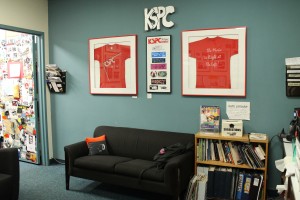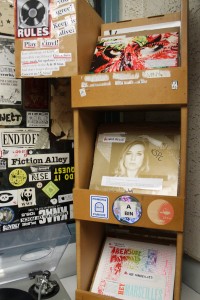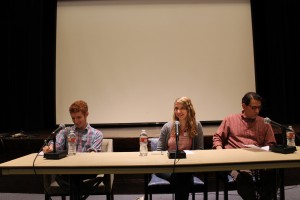On Saturday, November 10, I was thrilled to be back at KSPC at Pomona College (Claremont, California) for the fall 2012 UCRN (University of California Radio Network) conference. Twice a year, student radio stations affiliated with University of California (UC) schools convene at a college radio station in order to talk shop, hear from radio experts, and learn from each other. Over the past few years, UCRN host stations have been opening up the conference to college radio stations outside of the UC system, which has been helpful as far as building connections between college radio stations all over California.
This was my 6th UCRN conference (I attended the Spring 2012 event at KUCI, the Fall 2011 event at KDVS, the Spring 2011 event at KCSB, the Spring 2010 event at KALX, and the Spring 2009 event at KZSC). Each event is unique, in that the station hosting determines the line-up of speakers, panels, and events. I have fond memories of a head-banding demonstration at KZSC in 2009 and of nibbling on home-made waffles at KDVS last fall.
The conference at KSPC on Saturday ramped things up technology-wise, by having a few speakers presenting from remote locations using video chat. Additionally, there were round-table discussions, panels, tours of KSPC, and a closing BBQ/party with DJs and live music.
Since I’d been a DJ at KSPC many years ago, I was very excited to see the station again. I ended up hanging out through two separate tours so that I could see every nook and cranny of the place. It looked largely the same, although some of the technology had been updated. Just this year KSPC was able to move its transmitter and antenna, meaning that the 88.7 FM station now reaches many more listeners in the Los Angeles area. I was also intrigued to see another version of the mysterious radio station call letter sign that I’ve been spotting all over the country (signed, “your friend Leo”).
Following the station tour, everyone headed over to Pomona College’s campus center in order to meet up for a keynote presentation. Pomona’s Director of College Radio, Erica Tyron, made some introductory remarks and noted that KSPC had been a part of UCRN since the mid-1990s. She said that with the fall conference, they wanted to “expand our network of radio friends,” by inviting people from nearby college radio stations in Southern California. Stations in attendance included six UC stations (KALX, KCSB, KUCI, KUCR, KZSC and UCLA Radio), as well as Chapman Radio (Chapman University, Orange), KCPR (California Polytechnic University, San Luis Obispo), KFJC (Foothill College, Los Altos Hills), KSBR (Saddleback College, Mission Viejo), KSPC, KXLU (Loyola Marymount University, Los Angeles), and KXSC (University of Southern California, Los Angeles).
Douglas Rushkoff‘s keynote presentation provided a great back-drop for the sessions to follow. Rushkoff, an author and media theorist, outlined the unique characteristics of radio and explained “radio is a distinct medium” with a “distinct purpose.” Rushkoff argued that radio is “emotional” and that it contains a “tremendous physical intimacy.” He contrasted radio with television, saying that “radio is still human,” whereas television is “flat,” and creates a more emotionally distanced viewing experience, making it more aligned with “irony” and “snark.” He expressed optimism about the future of radio (in fact he’s in the process of producing his own radio show) and said that “radio is in a renaissance” and “should be seized upon.”
During a question and answer session following his keynote, Rushkoff said that live radio is more compelling to him than pre-recorded programming. He said, “Not live radio really bothers me on some level…Once it’s not live…it doesn’t keep me company [in] the same way.” He continued, pointing out that when a show is live, “at least I know…there’s another human being there.” Rushkoff also argued that he thinks radio “will move towards live local” since “nationwide brands” are “failing us” and since people are craving connections with their local communities.
Following Rushkoff’s presentation, representatives from each station in attendance had the opportunity to make introductions and address the entire group before dispersing for lunch in Claremont Village (where many took advantage of discount coupons to local record shop Rhino Records). After lunch, attendees were able to choose between a session about “enlivening your website” or another about “legal issues for college stations.” Following that there were sessions on “doing good radio” (focused on music shows) and “news tips and tricks.” The final time slot of the day had four different roundtable discussion options (music directors, news and talk programmers/directors, volunteer management, and publicity/promotions/events) as well as a meeting of the UCRN steering committee (primarily advisors and student managers).
I’m always excited about the opportunity to hear from legal experts, so I attended the “Legal Issues for College Stations” panel after lunch. Broadcast attorneys John Crigler and Melodie Virtue spoke to us remotely via a Google Hangout video chat, after representatives from KSPC outlined details about license renewal, copyright rules for streaming stations, and LPFM opportunities. Crigler talked a bit about FCC fines and explained that college radio stations have historically been treated the same as large commercial stations. He said that this may be changing in the future and speculated that the FCC may “show a little mercy” for college broadcasters who have violated FCC regulations. He said that he and Virtue were working with College Broadcasters Inc. (CBI) in order to persuade the FCC to adjust fines for student broadcasters since in many cases the fines can be as high as a station’s annual budget. Crigler recommended that stations do self-inspections annually by following the check-list on the FCC website. He said that it can also be helpful to team up with another station in order to inspect each other or connect with a state broadcast association for a low cost inspection. By having a state broadcast association do an “alternative inspection” (such as the service provided by the California Broadcast Association) one’s station will also get a 3-year pass from the FCC as far as random inspections go.
Following the legal panel, I sat in on the “Doing Good Radio” session. A panel of KSPC DJs talked about not only the concepts behind their music shows, but also about their own personal tricks of the trade. A short documentary featuring a wider group of KSPC DJs was a nice addition to the panel, as it gave a broad perspective on the range of shows and DJs at KSPC. In the discussion that followed, people also shared tips about ways to connect with one’s campus community via events, promotions, and technology (including iPhone apps and special streaming stations that can be played in public areas on campus).
The day concluded with roundtable discussions, which were following by a get-together in the quad between the Thatcher Music Building at Pomona (where KSPC is housed in the basement) and the Pomona College Museum of Art. DJs munched on BBQ fare, traded station swag (stickers, T-shirts, bags, etc.), made new friends, and listened to live music and DJs as darkness fell on Claremont.





